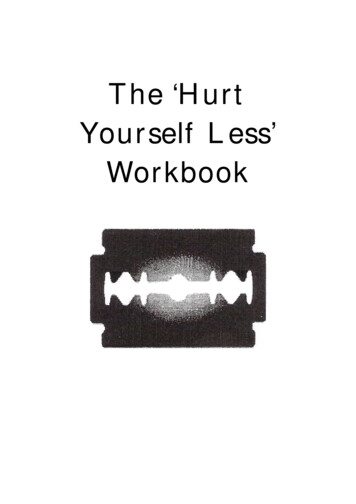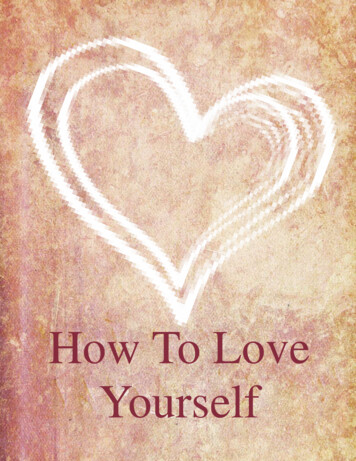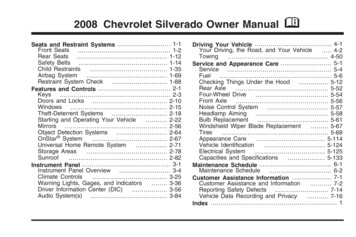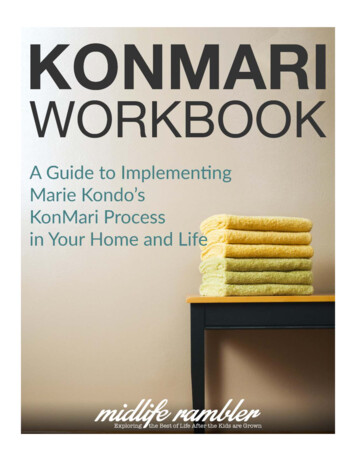
Transcription
The ‘HurtYourself Less’Workbook
By Eleanor Dace, Alison Faulkner, Miranda Frost, Karin Parker, LouisePembroke, Andy Smith 1998 Eleanor Dace, Alison Faulkner, Miranda Frost, Karin Parker, LouisePembroke, Andy Smith except First aid advice Dr. J. King GPFirst published by The National Self-Harm NetworkPO BOX 16190LONDON NW13WWISBN 0 9534027 0 32
Dedication:This book is dedicated to those self-harmers whodidn't survive, and to all those still surviving.ContentsFOREWORD4INTRODUCTION8WHO IS IT FOR?9YOU10YOUR SELF-HARM NOW14LOOKING AFTER YOU AND YOUR INJURY20MANAGING OTHER PEOPLE'S RESPONSES21YOUR SELF (THE DIFFICULT BIT)26THE ROOM - YOU IN YOUR ENVIRONMENT33WHEN YOU FEEL LIKE HARMING46THE FIRST TIME49YOUR INJURY NOTES (CONFIDENTIAL)53FOR WORKERS, CARERS AND CONCERNED OTHERS58YOU HAVE SURVIVED60MOVEABLE/MULTIPLE SECTIONS61HEARING VOICES, SEEING VISIONS, OTHER UNUSUALEXPERIENCES AND SELF-HARM62WHERE ARE YOU NOW 1?72WHERE ARE YOU NOW 2?73FIRST AID75RESOURCE LIST773
ForewordSelf-harm presents health care professionals with a number of complexchallenges. It takes us to the heart of the conflict between control andresponsibility upon which most professional interventions are based. Inaddition to this, professional 'talk' about self-harm occurs within a rationalistframework, which disguises a set of moral judgements about the nature of theact. These judgements, almost exclusively negative, deplore the act, andregard it as unacceptable. At the same time, the response of professionalagencies is curiously ambiguous. Sometimes, the mental health act is used totake control away from the person, in a (usually) futile attempt to preventrepetitions of the act. On other occasions, the person may be told s/he canonly receive help if they agree to take full responsibility for themselves byagreeing to stop harming themselves. These responses place the person whoself-harms in a situation of great uncertainty, in which it may be very difficult topredict how helping agencies will respond. It is not surprising, therefore, thatpeople who self-harm frequently have negative experiences of professionalinterventions, in the GP's surgery, the casualty department, the psychiatricdepartment. This fact is the main reason for the existence of this workbook. Inthis respect it is worth noting that this workbook contains a section on themanagement of other people's responses to self-harm.It is worth dwelling on the ambiguity of professional responses to self-harm.One way of trying to understand this is to consider the values and judgementsthat our culture makes about different types of self-harmful behaviours. Thefirst point to make here is that there are many forms of such behaviour,including ritual self-harm, unintentional self-harm, and deliberate self-harm.Ritual self harm includes acts which occur within a set of shared cultural orreligious beliefs, within which they token a particular significance or meaning.A distant Western relative of this is the fashion for body piercing andadornment with studs and rings. Unintentional self-harm occurs when aperson engages in an activity in which bodily harm arises as a consequence,although this is not the main objective. Examples include smoking tobaccoand drinking alcohol for pleasure, and participation in dangerous sports.Intentional self-harm includes a variety of different behaviours with differentobjectives. These include the taking of overdoses of tablets either with, orwithout suicidal intent, as well as the self-infliction of cuts, burns andlacerations to the skin. Some people refer to this as self-mutilation, but thefact that it is frequently talked about both popularly and by experts as acategory of self-harm, means that it is often confused with the taking ofoverdoses. From here arises the mistaken assumption that self-mutilation is aform of suicidal behaviour. Self-mutilation rarely has suicidal intent, but servessome other purpose.Psychiatry has attempted to bring the might of DSM-41 down on the problemof self-harm. Although it is not recognised as a psychiatric disorder in its ownright, this is not for the want of trying. Pattison & Kahan's (1983) approach toturning self-harm into a psychiatric disorder is worth considering in somedetail, because it provides an insight into the judgements and assumptions1DSM-4 (Diagnostic and Statistical Manual, fourth edition) is the handbook for the diagnosis andclassification of diseases used in America.4
which are associated with the category. They present 56 case historiespublished in psychiatric journals between 1960 and 1980, and describe arelationship between certain aspects of self-harm, such as its frequency, ageof onset, and gender, and psychiatric diagnoses. They also reviewedbiological theories of self-harm, which attempt to explain the behaviour interms of disturbances of chemical transmitters in the brain. This has importantimplications. If we can explain self-injurious behaviour in terms of disorderedbrain function, then there is no need to consider other ways of understandingit. Neuroscientific accounts of what psychiatrists call psychosis divorce humanexperience from interpersonal, social, cultural and political contexts (Thomas,1997). This also applies to neuroscientific explanations of self-harm. Inparticular, biological explanations mean that we no longer have to considerthe role of the tragically abusive aspects of human relationships. But there ismore to it than this.Pattison and Kahan try to extract what they call a 'prototype model' of the selfharm syndrome (Table 1), by comparing self-harm with other types of selfdestructive behaviours. They classify self-harmful behaviours in two ways.The first specifies whether or not self-harm results intentionally (direct) orunintentionally (indirect) from the behaviour. The second concerns theseverity or lethality of the self-harm. In addition, each category is furtherbroken down into multiple or single episodes. For example, someone whoattempted suicide by hanging would be committing a highly lethal act of selfharm, in which self-harm was a direct intention of the behaviour. What thetable reveals are the values that underpin the different categories. This can beseen if we consider the example of the stunt artist, and expand this to includea range of human activities such as participation in dangerous sports, such asmountaineering or motor racing. There are also situations which arise whenordinary members of the public put themselves at risk to save the life of adrowning person, or someone trapped in a fire. These behaviours areassociated with a very high risk of death or self harm (indirect), yet culturallythey are not only permitted, but valued. Sports people who engage in riskyactivities are held in high esteem, heroes whom we admire. The same appliesto members of the public whose acts of altruism are rewarded. The value thatunderlies these 'positive' behaviours is that it is a matter of individual choice,because people choose to climb high mountains or drive racing cars. Thehero chooses to rush into the burning building to rescue a child, or to plungeinto the freezing water to make a rescue. The exercise of this choice is seento be a rational act. This even applies to the category of heavy smokers whichappears in the table. Everyone knows that smoking is harmful, but no-onebelieves that smokers are irrational simply because they choose to smoke.They are exercising their personal freedom in choosing to smoke. Indeed, it isthe fact that they are free to choose that makes them rational. People whoharm themselves are viewed differently because they appear to have littlecontrol over what happens. Their freedom seems to have been constrained.Climbing a mountain or saving someone from a fire are seen to be sociallydesirable, involving self-control or self-sacrifice. The converse of this is thatcertain types of self-harm are undesirable, especially when deliberate. Suchacts are perceived as indicating lack of control, and self-indulgence, orsomething that does not occur through freedom of choice. This contributes tothe perception that such acts are irrational, with the consequence that those5
who engage in the behaviour are to be castigated for their lack of self-control.This, together with the popular misconception that the act carries suicidalintent, means that those who self-harm are reviled, accused, neglected andabused in casualty departments, GP's surgeries, psychiatric out-patientclinics, and in-patient units. How can this be changed?It seems to me that there is no way forward unless we all accept afundamental fact: that for many people self-harm is an essential copingmechanism, and we have no right to demand that people stop it, unless wehave something better to offer them. As we have nothing better, we have aresponsibility to ensure that the act is responded to as sensitively as possible,and that we take all steps possible to help minimise the physical harm thatcan arise from the act, and the secondary emotional harm, which, sadly, is alltoo often a consequence of the negative response of professionals. TheNational Self Harm Network has already taken a lead in specifying changes inthe ways in which professional services respond to people who self-harm. Thehealth service has a responsibility to respond constructively to this, in the areaof the training of professionals, and their ability to impart knowledge andprovide resources that would make self harm safer, and supporting self-helpinitiatives. This workbook is a major contribution to the field of self-help andself-management. Its contributors bring together a rich and unique body ofexperience and know-how, and this is presented in a manner that will helpyou to feel more in control of what is happening. It provides a comprehensive,and well thought out guide to all aspects of self-harm, and does so in a waythat is non-threatening and easy to follow. This work-book will help you to starttaking control again. It has my full support, and I wish you well in your journeythrough it.Dr. Phil Thomas M.Phil, D.P.M., F.R.C.Psych.Consultant Psychiatrist Bradford Community Health Trust, and SeniorResearch Fellow, University of BradfordReferencesPattison, E.M. & Kahan, J. (1983) The deliberate self-harm syndrome.American Journal of Psychiatry, 140, 867 - 872.Thomas, P. (1997) The dialectics of schizophrenia. London: Free AssociationBooks.6
Classification of self-harmful behavioursHigh LethalityDirectIndirectSuicide attemptTermination of vitaltreatment such asdialysissingle episodeHigh-risk performance(e.g. stunts)multiple episodessingle episodeMedium LethalityLow LethalitySuicide attemptsmultiple episodesAtypical deliberate selfharm syndromeAcute drunkennesssingle episodesingle episodeDeliberate self-harmsyndromeChronic alcoholismsevere obesityheavy cigarettesmokingmultiple episodesmultiple episodes(From Pattison & Kahan, 1983)7
IntroductionWe wanted this book for us, years ago. Now it's here, we hope it can beuseful for you. We didn't want a patronising "here's how you do it" book andtried to make it as interactive as possible so it becomes your book not ours.As we wrote it we did all the exercises, abandoning some because they weretoo painful for us; if you feel the same about any of it, don't do it.We all found something new about ourselves and our harm. We reached agreater understanding of it - we hope you will too. As well as showing our ownstuff in the text we made up a composite character, Lamake, just to give youexamples that were real.The book's not bound but in a folder so you can use it in any order you want:There is no right way - and you don't have to start with page one, or use everypage. Feel free to copy the sheets you want; we had in mind several bitscould be used again and again. We also thought it might be useful to keepwhat you do, even for a few years as self-harm has a way of reappearing inlives, even after a long time.We learnt a lot writing this book .We survived writing it; we hope you surviveusing it.The project was co-ordinated by Louise Pembroke.The authors:Andy has lived with voices for 40 years and self-harm for 24. When nothousebound he likes to harass psychiatry and apologise at Olympic level forhis country.Eleanor has survived 27 years of self-harm and is a voice-hearer who after afew years in the wilderness has recently rejoined active campaigning.Miranda struggles to be well balanced on the edge and contributed to thisbook to stay there.Karin has self-injured for at least 17 years and hopes the next few will be lessof a battle, though things and people are worth fighting for.Alison believed until fairly recently that she would never harm herself again;although rediscovering it has been a painful experience, finding that she's notalone with it has been a source of enormous power and support.Louise is a voice-hearer who self-harms and has been an active campaignerfor longer than she cares to remember. She likes to take her 4-foot Wile E.Coyote out for tea.8
Who is it for?This book is for you - if you self-harm or feel at risk from self-harm. By selfharm we mean any activity that you do to yourself that is not kind or hurtsyourself. For many people this is cutting, burning, overdosing, alcohol - but itcould be anything from relationships to computer games. Only you can decidewhat is and isn't.This book is to help you explore and understand it. It's not a 12-stepprogramme, it's not got the answers but it helps you look for them. It's hardwork. While you are using it, if it is too difficult take a break. Put it downforever if that's best. You might choose to use just parts of it. You might wantto do bits again and again. Whatever helps you make your picture is right foryou.It's not designed to be worked through with professionals but if you do want toshare anything from it, choose what you want and whom you want to share itwith. Taking risks like this can be very frightening but also very rewarding.Good luck and be kind to yourself.This book belongs to . .9
YouYour life as you remember itThis is a space for you to say the important events of your life as youremember them, when and if you feel able to. You may find it easier to do adrawing or a timeline (see later for an example).10
Things and people who have made you who you areYou may want to include family, friends, teachers, pets, illnesses, jobs,institutions, religion and beliefs, money, housing - anything you think isimportant.11
Your self-harmIs there anything you've just written about that you feel affected your selfharm? This can be positive or negative. You may want to think about, e.g. thefirst time you self-harmed - where you were, what you did, how you harmedyourself, what was happening, how you felt before, after etc. Are there anydifferences now in what you do?12
Self-harm timelineIf you have been self-harming for a while, has it changed? Has it evolved?Have you developed rituals? Do you do different things? Are there times whenyou have not harmed? These times may be very important to you too. Markthese on the line.13
Your self-harm nowYour self-harm may well have changed over the years, and may continue tochange. This section looks at your self-harm and what it means now. Youmight want to fill this in more than once, over several years. It may be differenteach time - don't worry, this could be really helpful to see the change. Even ifafter a few years you start again, you might find what you write now useful.Many of us have found that we returned to self-harm after years of not doing itand felt like failures - looking at self-harm as success or failure is not at allhelpful and could be another stick to beat yourself with. Understanding whenand why and how might help you retain control and accept what's happeningand break out of or limit a period of harming.We've got Lamake to fill one in as an example.14
Example timeline for Lamake1960 born1964 frightened by lion at zoo1966 tonsillectomy (didn't like hospital)1968 went to camp with brownies1970 grandma died (my best friend)1974 had abortion1975 kicked out of schoolFirst overdose1976 left home; returned (failure)1977 started FE collegetook overdoseFirst cut1978 caught shoplifting1979 bought cat1981 father diedadmission to psychiatric hospitalassaulted charge nurse1982 raped by four men; stopped eating, cat died1983 fell in love1984 moved in with partner1986 passed driving test1990 first cut since with partner1991 partner leaves; cutting goes through roof1992 find dog1993 buy flat1994 go into therapycutting, bulimia,First burn1995 holiday to California1996 new partner1997 join self-harm networkshare experience for first time15
How you feel BEFORE you self-harmThinking of your most recent experience of self-harm, answer any of theseyou feel comfortable with:Describe what happenedWhat led you to do it?What did you feel before?What else was important at the time? (Events, thoughts, memories,exhaustion, voices etc.)Was there anything else in the background? (This may be something currentor an echo from the past)Did you spend a long time thinking about harming, or was it impulsive, orboth?Is that your usual way (if no, what was the difference)?How do you feel now?16
How you feel after you self-harmThinking of your most recent experience of self-harm, answer any of theseyou feel comfortable with:How did you feel immediately afterwards?How did you feel a bit later?How do you feel about it now?How do you think your self-harm has helped?How do you think it doesn't help?Is there anything you would have done differently?17
How Lamake felt before self-harmThinking of your most recent experience of self-harm, answer any of theseyou feel comfortable with:Describe what happenedI ran a bath and whilst in the bath cut my left arm with a razorWhat led you to do it?My CPN has leftWhat did you feel before?Despairing and isolatedWhat else was important at the time? (Events, thoughts, memories,exhaustion, voices etc.)Remembering other times when I felt friendless and aloneWas there anything else in the background? (This may be something currentor an echo from the past)I've been finding it hard to get out to do my shopping and I was feelingdesperate to see my CPNDid you spend a long time thinking about harming, or was it impulsive, orboth?Both; been thinking of it for a while but this was the final strawIs that your usual way (if no, what was the difference)?No. I'm not usually in the bath.How does that feel?It made me more aware of the importance of cleaning wounds18
How Lamake felt after self-harmThinking of your most recent experience of self-harm, answer any of theseyou feel comfortable with:How did you feel immediately afterwards?CleanHow did you feel a bit later?ConfusedHow do you feel about it now?Relieved that I did it when I did because if I left it for longer it would have beenworseHow do you think your self-harm has helped?It made me focus on what I was really feeling distressed aboutHow do you think it doesn't help?My CPN has still left and that hasn’t changedIs there anything you would have done differently?No.19
Looking after you and your injuryIf you have just injured yourself before doing this look at your wound. Does itneed first aid? Check the section at the back. This may be particularlyimportant if you feel your injury was forced on you by voices.When you've dealt with the injury, think about yourself.Do you need to be with someone, or alone?Is there anyone who can help over the phone?What do you find helpful when distressed? (Bath, hot water bottle, TV, musicetc.)20
Managing other people's responsesOften the most difficult aspect of our self-harm is how other people react to usand how that leaves us feeling. Sometimes we find ourselves dealing withother people's feelings as well as our own. Examples of other people'sreactions include: fear, loathing, disgust, horror, upset, disappointment, angry,blaming, guilty, cold, shaming, helplessness, wilful ignorance, inappropriatecomments.Think about a time when someone was unhelpful.What was it that they did or said that was unhelpful to you?Did you say or do anything?How did you feel?Was the person's response justified?. Can you say why?What could they have said or done that would have been more helpful?What is the best thing they could have said or done for you at that time?Are they aware that what they said or did was unhelpful to you? Yes/NoIs there anything you could do that would help them to change their responseto you?What would you like to say to them now?Remember: if you feel brave enough, you can always try to say this to them.You deserve to be treated well and respectfully; and not to have to educateothers whilst in distress.21
Is there a time when someone responded helpfully to your self-harm?What did they do or not do that was helpful?How did it help?How did you feel as a result?What was the most important thing about this experience? (Can you try toremember this when you are next feeling bad?)22
Safe peopleThis part looks at who is in your life and how safe you feel with them.Draw yourself in the centre of the page. As close as you want, put the personyou feel safest with At the very edge of the page, draw the person you feelleast safe with. Place everyone else around the page as close to you as youfeel comfortable with.Other examples are given over the page. When you have drawn your diagram, think about what makes the safe peoplesafe.For the unsafe people, it might be helpful to imagine them on another planet,locked in a dark prison out of their heads on acid, with a famous personalityinterviewing them in the psychiatrist’s chair.Write your own fantasy here:23
24
When we drew our examples we talked about them for a while. The pictureswere not as important as the process which revealed just how complicatedfeeling safe with people could be (and these shift in time).Some of us felt guilty about not putting certain people into the picture e.g.'mother should be there', or not valuing others as much as they might valueus. Another common feature was people shifting from one area to anotherover time e.g. a partner then becoming an ex or friends becoming moredistant; the only constant factor being ourselves. One of us has used thisexercise repeatedly and it's helped her understand what types of people maybe safer to be around, and to develop a few emotional limits in relationships.Really close relationships can be very confusing as you can 'merge' with theother person to the point of losing yourself When this relationship changes orends you might feel you have to re-establish the limits of your own being byharming – actually testing your physical boundaries out to find where they are.It's okay to move people into 'safe corners' a long way away; you may want togo to meet them when you choose, e.g. having an answer phone to screencalls can protect you from unmanageable contact with others, particularlythose in the corners. Modem technology has its advantages.The 'safe zone' can change in size and can then include a lot of people whomay then become safe. If you are feeling pretty good, it might be quite largebut if you feel low you may find you are the only person in your safety zone.Or you might not even be there yourself if you are really scared! Don't worry it will change. Don't destroy your own safety zone.25
Your self (the difficult bit)We've had real difficulty writing this so guess it will be hard to fill in - so don'tworry if you can't! We're trying to look at how self-harm relates to how you feelabout your body and your self. This is a minefield and you may find itdistressing - it's not compulsory but may be very helpful. Take what you can,and what you want from it. Try doing this a couple of times - once when youfeel okay and maybe then when you think harming is going to be an issue.'If I were' gameThese questions help you assess how you see yourself in the world.Jot down the answers without thinking too much!If I were a politician I would beIf I were a pop star I would beIf I were a film star I would beIf I were in a soap opera I would beIf I were a writer I would beIf I were a book I would beIf I were a chat show host I would beIf I were a criminal I would beIf I were a religion I would beIf I were a mythical beast I would beIf I were a Disney character I would be26
If I were a drug I would beIf I were an animal I would beIf I were a piece of food I would beIf I were an illness I would beIf I were a mood I would beIf I were a holiday resort I would beIf I were a pattern I would beIf I were a tree I would beHave a look at what you've written. Anything you notice or is unusual, or has atheme, e.g. you would be something weak but want to be something strong;you would be fat but want to be thin etc.If you have played this game twice is there a difference between youranswers?Do the answers depend on when you want harm yourself?Do the answers depend on when you might harm yourself?Do the answers depend on when you have harmed yourself?27
We all have aspects of ourselves that may be deeply buried e.g. strength,nurturing, etc. that feel too threatening to acknowledge. Self-harm can be away you use to find or suppress these parts. These questions are to help youexplore for yourself how.Does your harm enable you to have feelings you don't have at other times e.g.anger?Does your harm put you in touch with aspects of yourself you don't otherwisefeel or acknowledge?What might these be?Is there another way you can get that same feeling?How?Is it less destructive?Does the care you show for yourself after your harm put you in touch withaspects of yourself you don't otherwise feel or acknowledge?What might these be?Is there another way you can get that same feeling?How?28
Body Image sheetOn the outline below, mark on in one colour the bits you feel okay about. Inanother colour mark the bits you don't.You may want to draw the outline again - showing a different shape and/orwith different marked areas. These may change over time.29
Body Question sheetA part of my body I feel okay about is:The reason is:I look after this part by:It may be paradoxical but sometimes we harm the parts of our body we feelgood about, as it can be an easy way to punish ourselves.Do you harm this part?How does the harm affect how you feel about it? (e.g. do you like it more orless)How does the harm make you feel about yourself (as a whole)?If you don't harm this part, have you thought of doing so?Are there areas you do not harm?Why do you think that might be?Are you scared that one day you might?30
Self-harm continuumYour thoughts about harm and injury are very important and may befrightening; you may never have shared them even though they are so vivid.Instead you may do lesser damage as a way of minimizing the harm e.g. youmay imagine cutting yourself into small pieces but end up cutting or otherwisedamaging your arm superficially. This relieves the pressure and the imagesmay subside.Do you think you do this?This may be frightening, but what are your scary thoughts?What are your ways of lessening the damage?You may find you have your own self-harm continuum; write or draw it out ifyou can. It might include: alcohol, abusive relationships, cutting, burning,eating, starving, swapping between activities etc. All these things areimportant at different times and may have a limiting effect on your self-harmand are interconnected. You may find that you self-harm more when you usealcohol, the cuts may be deeper than at other times. You may use self-harmto limit eating distress or vice versa. The more you repeat this exercise themore useful it can become. You might find you see patterns emerging in yourharm. You may substitute one form of harm for another, or use one type ofself-harm to limit the degree of another. For example, you may use alcohol toreduce the severity of a cut or burn.31
Self-harm continuumSafer optionsUnsafe optionsVery unsafe options32
The room - you in your environmentTo help you think about your environment and your relationship to it, imagineyour world as if it were your room or your home. Where you live, you probablyknow where you keep the things you use to harm yourself. Sometimes theymight be visible, at other times they might be somewhere out of reach butaccessible. They may even mean leaving them in the shops if you need themto be. Our tactics are all different, and again change with time. You may notbe aware of your own, but if you have injured more than once youundoubtedly have them. Other people may want to take the implements away;think carefully before allowing this as being denied access to them mightmean you do something worse e.g. cutting with a dirty blade.Some tactics might be: leave it in the shop if you feel at risk have it there but out of immediate reach having something to do it with in sight at all times as a reminder not to trying for something less harmful e.g. drinking beer not spirits changing the harm to a different type - e.g. going shopping and damagingyour bank balanceThe list is contradictory in places. This is no surprise - as there are uniquestrategies for unique individuals.We thought about where we were in our rooms, and the things we use toharm and to nurture. We drew our imagined rooms with the things around us.33
‘In my room I am huddled in a corner nearest the door. Around me are all thedifferent implements I use to harm myself, e.g. knives, cigarettes (for burning),laxative pills, and food. In the far corners of the room are things which offercomfort to me i.e. my cats and books. However I am unable to get to thingswhich comfort me most of the time.’‘In my ideal room I am no longer huddled in a corner but am standing proud inthe centre of the room. I am surrounded by comforting objects and theimplements I u
Books. 7 Classification of self-harmful behaviours Direct Indirect High Lethality Suicide attempt single episode Termination of vital treatment such as dialysis single episode Medium Lethality Suicide attempts multiple episo










